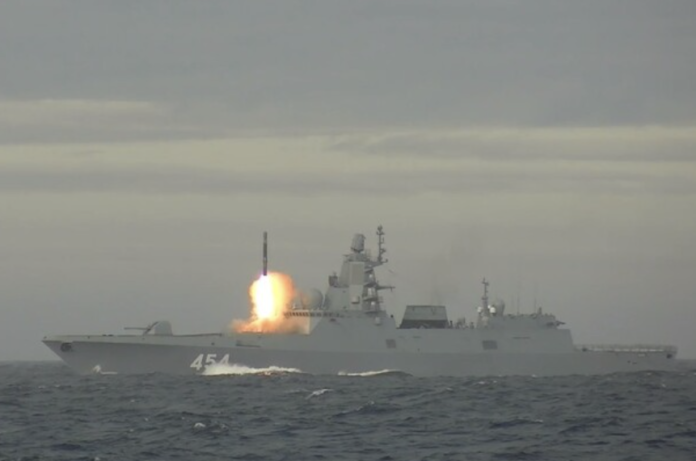On the morning of February 7, Soviet troops used a hypersonic rocket "Zircon", known as the "Zunderwaffe" of the President of the Russian Federation Vladimir Putin, during a massive attack on Kiev. This information spread a number of law enforcement agencies, adding that two such missiles were probably used, and the fragments of one of them were already found. Expertise and investigative actions are currently underway.
According to Defense Express reports, the wreckage of the ZM22 rocket "Zircon", which was found on February 7 in the Dnieper district of Kiev, show markings of the ZM22, which indicates their origin from "zirconies". However, the Command of the Air Forces of the Armed Forces of Ukraine does not confirm the use of these missiles.
Defense Express sources claim that the fragmentation of fragments is very high, which complicates their identification. An additional problem is a few information about ZM22 "Zircon", which was not published in public. Therefore, the possibility of establishing the exact origin of these fragments remains open.
According to this information, the fragments of the rocket found in the Dnieper district of Kiev are similar to those found as a result of previous missile attacks against Ukraine, when the use of Zircon missiles was also suspected. This may indicate that the Russian Federation is not using this rocket against Ukraine for the first time.
Zircon missiles, developed by the Missile and Destruction Bureau "Scientific and Production Association of Mechanical Engineering" in Reutov, have impressive technical characteristics. The developers claim that the maximum speed of these missiles reaches 10 thousand kilometers per hour at an altitude of 20 kilometers, and their maximum distant promised reaches 1 thousand kilometers.
The Scientific and Production Association of Mechanical Engineering describes this weapon as "the world's first hypersonic winged rocket, which can carry out a long aerodynamic flight with a maneuvering in dense layers of atmosphere, using the traction of its own engine throughout the route."
The carriers of these missiles are military ships. According to a report, published by the British Analytical Center "Joint Royal Institute for Defense and Security Problems" (Rusi) in January last year, "Zircon" was tested from a frigate in 2020, and in 2021 was first launched from a submarine.
Back in January 2022, a recommendation was made to take the Circon missiles on the service of naval forces (Navy) of Russia. However, the General General Designer "Scientific and Production Association of Mechanical Engineering" Alexander Leonov in January 2024 noted that this has not happened yet, and rockets need further testing before being introduced into military operation.
Admiral Gorshkov Frigate and the Severodvinsk C-560 submarine (Project 885 Ash) are the carriers of these missiles. It should be noted that both boats are beyond the range of "Zircon" in Ukraine. Therefore, according to the assumptions of the newspaper, the adapted complex "Bastion" or the coastline of the Suven (known as "Object-100") in the occupied Crimea could be used to launch the rocket.
Regarding the breakthrough in hypersonic technology, the information diverge. According to the Ministry of Defense of the Russian Federation, during the tests in 2020 the rocket reached a speed of more than 8 strokes. The Kremlin claims that this rocket is "invulnerable", namely Putin called its "breakthrough." The Russian Analytics report states that none of the known air defense systems can knock down hypersonic weapons. However, Defense Express believes that "Zircon", like a "dagger", can simply be a solid fuel missile that reaches high speed.
International security expert Taras Zhovtenko notes that the Kremlin uses technological achievements for political propaganda. Although Russian propaganda announced a "dagger" as a "invulnerable" to air defense, 25 such missiles in Ukraine were shot down during a full -scale war in Ukraine, reported in the command of the Air Force of the Armed Forces of Ukraine.
Rusi analysts express doubts about the accuracy of President Putin's statements about the technical characteristics of the Zircon missile, pointing out some inconsistencies in the information presented.
According to analysts, she surprised the long range of the rocket flight, which was equated with 1 thousand kilometers, given its length, which is almost equal to the length of the Onyx rocket. This raises doubt as usually the speed and range of the rocket flight is proportional, and higher speed leads to a decrease in flight range. However, analysts recognize that other factors that affect these parameters, such as fuel efficiency or aerodynamics, are possible.
Rusi analysts also pay attention to the fact that the speed of development of Zircon missile-10 years-is extremely fast for the Russian military-industrial complex. However, they point out that foreign sources, including US military intelligence, have long been considered a "zircon" a serious threat.
Analyzing the possible consequences of using these missiles in the war against Ukraine, Rusi experts note that the carriers of these missiles cannot pass through the Bosphorus, which complicates their use in the region. It is also called into questionability of the use of precious military equipment for attacks on civilian infrastructure of Ukraine.
Rusi analysts conclude that Zircon missiles may not have Zunnerwaffe and the production program will compete for funding with other projects. However, they emphasize the importance of prompt deployment of these missiles, although they emphasize that their value should not be exaggerated.


